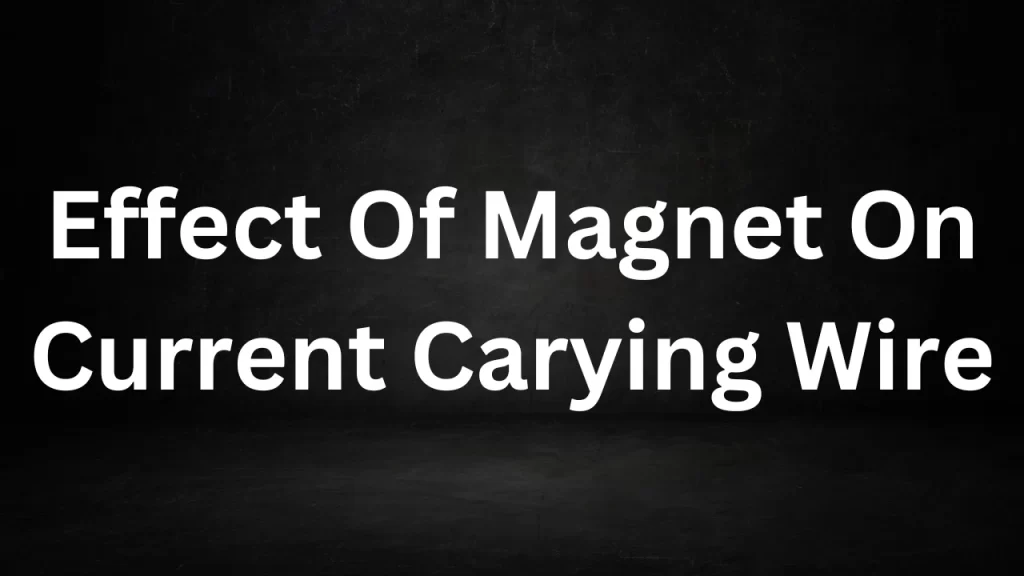Effect Of Magnet On Current Carying Wire: The interaction between magnets and electric currents is a fascinating aspect of electromagnetism, a fundamental branch of physics. This interaction has led to the development of various technological applications, from electric motors to generators.
In this article, we will explore the intriguing effect of magnets on current-carrying wires, shedding light on the principles behind it and its real-world applications.

Effect Of Magnet On Current Carying Wire
The Basics of Electromagnetism
Electromagnetism is a branch of physics that deals with the relationship between electric currents and magnetic fields. It was James Clerk Maxwell who, in the 19th century, formulated the fundamental equations that describe how electric charges and currents generate magnetic fields and how changing magnetic fields induce electric currents.
The Right-Hand Rule
One of the key principles in understanding the interaction between magnets and current-carrying wires is the right-hand rule. This rule states that if you point your thumb in the direction of the current flow (conventional current, from positive to negative), and you curl your fingers, the direction in which your fingers curl represents the direction of the magnetic field lines around the wire. The strength of the magnetic field depends on the current intensity and the distance from the wire.
The Effect of Magnets on Current-Carrying Wires
When a magnetic field interacts with a current-carrying wire, several important phenomena occur:
- Magnetic Force: The magnetic field exerts a force on the wire. This force is perpendicular to both the current direction and the magnetic field direction and is described by the magnetic force formula: F = I * B * L * sin(θ), where F is the force, I is the current, B is the magnetic field strength, L is the length of the wire in the field, and θ is the angle between the current and magnetic field directions.
- Lorentz Force: The magnetic force on the wire is part of the larger Lorentz force, which includes the electric force on charged particles within the wire. This combined force can cause the wire to move or experience a torque.
Applications of the Effect
- Understanding the effect of magnets on current-carrying wires has a multitude of practical applications:
- Electric Motors: Electric motors utilize the interaction between magnetic fields and current-carrying wires to convert electrical energy into mechanical motion. This principle is at the core of various appliances and machines.
- Generators: In generators, mechanical motion is used to move wires through magnetic fields, inducing electric currents. This process is how electrical energy is generated in power plants.
- Magnetic Sensors: Magnetic sensors and compasses rely on the interaction between magnetic fields and current in coils to detect and measure magnetic fields, providing critical information in navigation and various industries.
- Transformers: Transformers use the principles of electromagnetic induction to change the voltage levels in electrical circuits, making power distribution and voltage conversion efficient.
Conclusion
The effect of magnets on current-carrying wires is a fundamental aspect of electromagnetism with profound implications in modern technology. It enables the creation of electric motors, generators, sensors, and transformers, all of which are integral to our daily lives. By harnessing the principles of electromagnetism, scientists and engineers have revolutionized the way we generate, distribute, and use electrical energy, making the world of technology and innovation possible. Understanding these principles is crucial for anyone interested in the fields of physics and electrical engineering.
Read More
- Simple Harmonic Motion Formulas
- Dipole Uniform Magnetic Field
- Light Filtering Polaroid Films Polarization
- Animals Biology Science Lion Zoology
- Difference Between Voltage And Current
Frequently Asked Questions (FAQs) Effect Of Magnet On Current Carying Wire
Q1: What is the basic principle behind the interaction between magnets and current-carrying wires?
A1: The basic principle is that a magnetic field exerts a force on a current-carrying wire. This force is perpendicular to both the current direction and the magnetic field direction and is described by the magnetic force formula.
Q2: What is the right-hand rule in electromagnetism?
A2: The right-hand rule is a convention used to determine the direction of magnetic field lines generated by a current-carrying wire. If you point your right thumb in the direction of the current, the curling of your fingers represents the direction of the magnetic field lines around the wire.
Q3: How does the strength of the magnetic field affect the force on a current-carrying wire?
A3: The strength of the magnetic field (denoted as B) directly affects the force (F) experienced by the wire. The greater the magnetic field strength, the stronger the force on the wire, assuming other factors like current and length remain constant.
Q4: What is the Lorentz force, and how does it relate to the effect of magnets on current-carrying wires?
A4: The Lorentz force is the combined force acting on a charged particle due to both an electric field and a magnetic field. In the context of current-carrying wires, it includes the magnetic force on the wire as well as the electric force on the charged particles (electrons) within the wire.
Q5: What are some practical applications of the effect of magnets on current-carrying wires?
A5: Some practical applications include electric motors, generators, magnetic sensors, compasses, and transformers. These devices rely on the interaction between magnetic fields and current-carrying wires to perform various functions, such as generating electricity, providing directional information, and converting electrical energy into mechanical motion.
